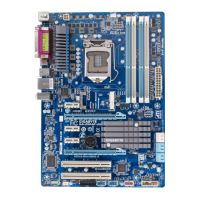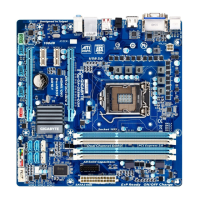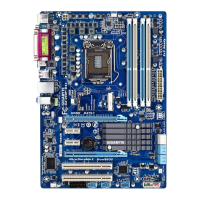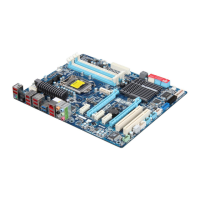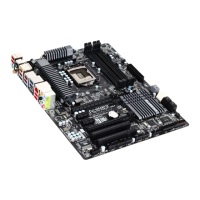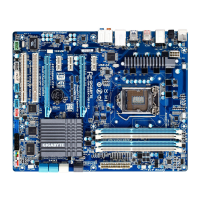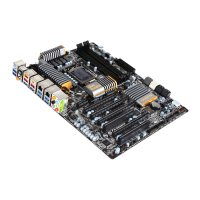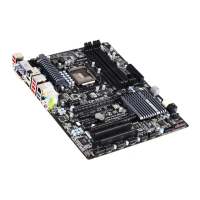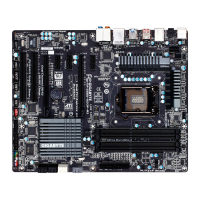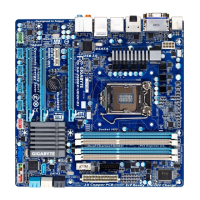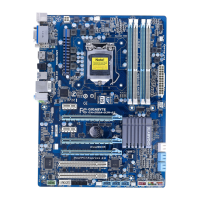
Do you have a question about the Gigabyte GA-Z68A-D3-B3 and is the answer not in the manual?
| Non-ECC | Yes |
|---|---|
| Memory voltage | 1.5 V |
| Memory channels | Dual-channel |
| Number of memory slots | 4 |
| Maximum internal memory | 32 GB |
| Supported memory clock speeds | 1066, 1333, 1600, 1866, 2133 MHz |
| Processor socket | LGA 1155 (Socket H2) |
| Processor manufacturer | Intel |
| Compatible processor series | Intel® Celeron® |
| Maximum number of SMP processors | 1 |
| USB 2.0 connectors | 3 |
| Number of SATA III connectors | 2 |
| Number of Parallel ATA connectors | 0 |
| USB 2.0 ports quantity | USB 2.0 ports have a data transmission speed of 480 Mbps, and are backwards compatible with USB 1.1 ports. You can connect all kinds of peripheral devices to them. |
| Component for | PC |
| Motherboard chipset | Intel Z68 |
| Audio output channels | 7.1 channels |
| Motherboard form factor | ATX |
| Compatible operating systems | Windows 7/Vista/XP |
| PCI Express slots version | 2.0 |
| On-board graphics card | No |
| RAID levels | 0, 1, 5, 10 |
| Bundled software | Norton Internet Security |
| LAN controller | RealTek RTL8111E |
| Ethernet interface type | Gigabit Ethernet |
| BIOS type | AWARD |
| ACPI version | 1.0b |
| BIOS memory size | 64 Mbit |
| Depth | 215 mm |
|---|---|
| Width | 305 mm |
Details conformity with EMC and LVD Directives, and FCC regulations.
Class B Digital Device declaration per FCC rules, including conditions for operation.
States copyright ownership and reserved rights for the manual content.
Notes manual content is protected by copyright and subject to change without notice.
Explains how to identify the motherboard's revision number for technical information.
Lists the standard items included in the motherboard package.
Lists optional accessories available for purchase with the motherboard.
Illustrates the physical layout of connectors and components on the motherboard.
Provides a high-level block diagram showing interconnections of major motherboard components.
Essential safety guidelines and handling procedures to prevent damage during installation.
Details the technical specifications of the motherboard, including CPU, memory, and expansion slots.
Step-by-step guide for installing the CPU and its cooler onto the motherboard socket.
Instructions for installing memory modules, including dual-channel configuration.
Guidance on how to install expansion cards into available slots on the motherboard.
Identifies and describes the function of external ports on the motherboard's rear panel.
Details the various internal headers and connectors on the motherboard for system components.
Explains the 24-pin ATX and 4-pin 12V power connectors for motherboard and CPU.
Details the pinouts and function of CPU, System, and Power fan headers.
Instructions for replacing the CMOS battery to maintain BIOS settings.
Details the SATA 6Gb/s and 3Gb/s connectors for storage devices.
Explains the F_PANEL header for connecting chassis power/reset switches and LEDs.
Details the F_AUDIO header for connecting chassis front panel audio modules.
Explains the SPDIF_O header for digital audio output connections.
Details the USB 2.0/1.1 headers for connecting internal USB brackets.
Instructions for clearing CMOS values to reset BIOS to factory defaults.
Information on connecting a TPM module to the motherboard header.
Explains the screens that appear when the computer boots, including LOGO and POST screens.
Describes how to navigate the BIOS Setup utility's main menu and use function keys.
Covers CPU and memory overclocking, frequency, and voltage settings for performance tuning.
Options for configuring CPU clock ratios, frequencies, and related advanced settings.
Settings related to CPU core performance, Turbo Boost, and power management features.
Controls for CPU base clock (BCLK) and DMI/PCIe bus frequency adjustments.
Options for tuning memory performance, including XMP profiles and timing controls.
Detailed configuration of memory timings (CAS Latency, tRCD, tRP, tRAS, etc.).
Adjustments for various system voltages, including CPU, Vcore, and DRAM voltages.
Configuration options for Isochronous Support and Intel Virtualization Technology.
Settings for system date, time, hard drive configuration, and memory information.
Options for boot order, security settings, and other advanced system configurations.
Settings for onboard devices like SATA controllers, USB, LAN, and Audio.
Cable diagnostic feature to detect LAN cable status and distance to faults.
Configuration options for ACPI sleep states, wake-up events, and power saving features.
Monitoring system temperatures, voltages, fan speeds, and case intrusion status.
Resets BIOS settings to the safest, most stable factory defaults.
Loads the factory default settings for optimal system performance.
Allows setting passwords to restrict access to BIOS Setup and system boot.
Saves current BIOS settings and exits the setup utility.
Exits BIOS Setup without saving any changes made.
Step-by-step guide for installing essential chipset drivers using the GIGABYTE utility.
Instructions for installing GIGABYTE utilities and other provided software.
Access to application guides, driver disk contents, and motherboard manuals.
Provides contact details for support and displays basic system information.
Links to GIGABYTE website for updates and lists new utilities for installation.
Utility for quick system data backup and restoration.
Details on using Q-Flash and @BIOS for updating the motherboard's BIOS.
Instructions for updating the BIOS using the @BIOS Windows-based utility.
Software for fine-tuning system settings, overclocking, and monitoring.
Tool for easy data sharing between computers on a network.
Introduces the Smart 6™ suite, including QuickBoot and QuickBoost for system management.
Utility for creating hourly partition backups and restoring system or files.
Features for personal password storage and system activity recording.
Tools for managing computer usage time and enabling power saving via Bluetooth.
Utility for quick RAID array setup and management for enhanced drive performance.
Overclocking utility allowing system tweaking via an internet browser.
Guide on installing and configuring SATA hard drives, including RAID setup.
Steps to configure SATA controller modes (IDE, AHCI, RAID) in BIOS.
Detailed steps for creating RAID volumes using the Intel Rapid Storage Technology BIOS utility.
Instructions for setting up and managing recovery volumes for data protection.
Procedure for deleting existing RAID volumes.
Guide for installing necessary RAID/AHCI drivers and the operating system.
Process for rebuilding a RAID array, typically after replacing a failed drive.
How to perform RAID rebuild operations using the Intel Rapid Storage Technology utility.
Steps to restore the master drive from a recovery volume.
Guide for configuring motherboard audio jacks for various channel setups.
Steps to set up speaker configurations (Stereo, 5.1, 7.1) in the audio manager.
Options for customizing audio environments and sound effects.
How to activate AC'97 front panel audio modules via the audio manager settings.
Procedure to mute rear audio output when a front headphone is plugged in.
Instructions for setting up digital audio output via the S/PDIF Out jack.
Steps to set up and configure microphone input for recording.
How to enable Stereo Mix for recording system audio output.
Guide on using the built-in Sound Recorder utility for audio capture.
Answers to common questions regarding BIOS options, system behavior, and troubleshooting.
A step-by-step flowchart to diagnose and resolve common system startup issues.
Lists contact details and web addresses for GIGABYTE support worldwide.
